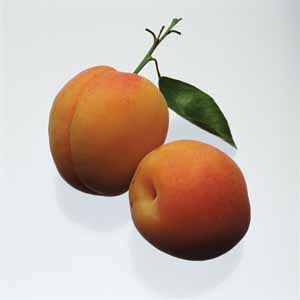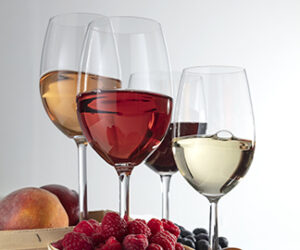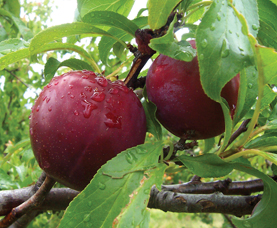If you have not tried making country wines — i.e. non-grape wines — this article’s
sole purpose is to entice you to try. To do this, I’ve collected 10 sure-fire
recipes just about guaranteed to yield good to great results. I say “just about”
because nothing in life except its finality is actually guaranteed. You could
select poor ingredients, forget to sanitize a spoon or racking tube, or use
additives past their shelf life. Barring a big mistake, however, these recipes
are tried and true and will ensure you a high probability of success. This collection
contains two recipes using dried fruit, two berry wines, two flower wines and
four fruit wines.
 Dried Apricot Wine
Dried Apricot Wine
This recipe can be made any time of the year. Stay away from dried apricots
containing sorbate, benzoate, sorbic acid, or benzoic acid. Makes one gallon (3.8
L).
Ingredients
- 2.0 lb. (0.91 kg) chopped dried apricots
- 1 can Welch’s or Old Orchard 100% White Grape Juice (frozen concentrate)
- 1 1/4 lb. (0.57 kg) demerara or turbinado sugar (if unavailable, may substitute
Sugar-in-the-Raw) - 1 1/4 tsp. acid blend
- 6 pints (2.8 L) water
- 1 tsp. pectic enzyme
- 1/4 tsp. grape tannin
- 1 crushed Campden tablet
- 3/4 tsp. yeast nutrient
- 1 pkg Red Star Côte des Blancs wine yeast
Combine all ingredients except yeast in fermenter. Stir to dissolve sugar,
cover and set in warm place for 24 hours. Add yeast, cover, and stir daily for
10 days. Strain into secondary fermenter, pressing pulp lightly. Top up to one
gallon (3.8 L) with water and fit airlock. Rack after 30 days and again after
an additional 60 days. When clear, rack again and bottle. Allow to age one year.
Dried Elderberry Wine
You can buy dried elderberries from most winemaking shops or pick plenty
of wild ones and dry them. Dried elderberries do not leave the residue, described
as “elderberry goo,” that defies conventional clean-up methods. Recipe makes
one gallon (3.8 L).
Ingredients
- 4–5 1/4 oz. (0.11–0.15 g) dried elderberries
- 2 1/2 lbs. (1.1 kg) sugar
- 7 3/4 pints (3.7 L) water
- 1 tsp. acid blend
- 1 tsp. yeast nutrient
- 1 crushed Campden tablet
- 1 pkg of Red Star Montrachet yeast
Bring water to boil with sugar. Stir until sugar is dissolved and water clear.
Wash dried elderberries and put in nylon straining bag with several sanitized
marbles for weight. Tie bag and put in primary. Pour boiling sugar water over
elderberries and cover primary. When cool, stir in crushed Campden tablet, yeast
nutrient and acid blend until dissolved. Recover and set aside 12 hours. Add
activated yeast and ferment until specific gravity drops to 1.010, stirring
and squeezing bag daily. Transfer liquid to secondary, fit airlock and ferment
to dryness. Rack every 30 days until wine clears and doesn’t drop even a dusting
of lees over a 30-day period. Bottle and enjoy. Improves with age.
Blackberry Port
Blackberry port is seldom made, but well worth the effort. Use fully ripe
berries, fresh or frozen. Makes one gallon (3.8 L).
Ingredients
- 6.0 lb. (2.7 kg) ripe blackberries
- 1 cup red grape concentrate
- 1/2 cup light dried malt extract
- 1 3/4 lb. (0.79 kg) granulated sugar
- 1/2 tsp. pectic enzyme
- 1 1/4 tsp. acid blend
- 4 pints (1.9 L) water
- 1 crushed Campden tablet
- 1/2 tsp. yeast energizer
- 1 tsp. yeast nutrient
- 1 pkg Lalvin K1-V1116 (Montpellier) or a port wine yeast
Wash and crush blackberries in nylon straining bag and strain juice into fermenter.
Tie top of nylon bag and place in primary. Stir in all other ingredients except
pectic enzyme, yeast and red grape concentrate. Stir well to dissolve sugar,
cover well, and set aside for 8– 12 hours. Add pectic enzyme, re-cover, and
set aside additional 8–12 hours. Add yeast, cover, stir ingredients daily, and
press pulp in nylon bag to extract flavor.
When specific gravity is 1.030 (about
5 days), strain juice from bag and siphon liquid off sediment into secondary
fermentation vessel. Fit airlock and set aside. Rack in three weeks and again
in two months. When wine is clear and well past last evidence of fermentation,
stabilize, add red grape concentrate, and set aside for 3 weeks. If no evidence
of re-fermentation, rack again and bottle. Allow at least a year to mature,
but will improve for several years.
Blueberry Wine
Ripe blueberries can be crushed fresh or frozen, thawed and crushed later.
Frozen blueberries in the supermarket were actually riper when picked than the
fresh ones in the produce department. Makes one gallon (3.8 L).
Ingredients
- 2 1/2 lb. (1.1 kg) blueberries
- 1 cup red grape concentrate
- 1 3/4 lb. (0.79 kg) granulated sugar
- 1/2 tsp. pectic enzyme
- 1 1/2 tsp. acid blend
- 1/2 tsp. yeast energizer
- 1 tsp. yeast nutrient
- 1/2 tsp. wine stabilizer
- 6 pints (2.8 L) water
- 1 crushed Campden tablet
- 1 pkg White Labs 749 AMH (Assmanshausen) or Lalvin 71B-1122 (Narbonne) wine
yeast
Wash and crush blueberries in nylon straining bag and strain juice into primary
fermentation vessel. Tie top of nylon bag and place in primary fermentation
vessel. Stir in all other ingredients except yeast, stabilizer and red grape
concentrate. Stir well to dissolve sugar, cover well, and set aside for 24 hours.
Add yeast, cover, and daily stir ingredients and press pulp in nylon bag to
extract flavor.
When specific gravity is 1.030 (about 5 days), strain juice from bag and siphon
liquor off sediment into glass secondary fermentation vessel. Fit airlock. Rack
in three weeks and again in two months. When wine is clear and stable, rack
again and add stabilizer and red grape concentrate. Wait 3 weeks and bottle.
Allow a year to mature. It will be worth the wait.
Hibiscus Flower Wine
Your health food market will likely carry Hibiscus sabdariffa flowers
already dried and ready to be crushed for tea. I generally buy dried red or
purple flowers, which makes a delicious bright red or deep purple wine. The
recipe makes one gallon (3.8 L).
Ingredients
- 2.0 oz. (57 g) dried hibiscus flowers
- 2.0 lbs. (0.91 kg) sugar
- 7 pints (3.3 L) water
- 1 1/2 tsp. acid blend
- 1 tsp. yeast nutrient
- 1 pkg Red Star Côte des Blancs wine yeast
Combine water and sugar and put on to boil, stirring occasionally until sugar
is dissolved. Tie flowers in nylon straining bag and put in primary. Pour boiling
sugar-water over flowers and stir in all ingredients except yeast. Cover primary
until water cools to room temperature. Squeeze flowers to extract maximum flavor
and then discard flowers or reuse for tea. Add activated yeast, re-cover the
primary, and stir daily until active fermentation dies down (7–8 days). Rack
to secondary, top up with water if required and fit airlock. Ferment 30 days,
then rack into clean secondary. Refit airlock and rack again after additional
30 days. Wait a final 2 months, rack again and stabilize wine. Sweeten to taste
and set aside 30 days. Bottle in dark glass. May drink immediately, but improves
in six months.
Cactus Flower Wine
If you live in an area where prickly pear cactus grows, this is a wonderful
wine, best served cool or cold. Look inside the flowers before harvesting them.
I found a bee in almost every one of them, but they left when I disturbed them.
With one hand gather the petals and with the other hand cut the petals off with
a long, sharp knife. The recipe makes one gallon (3.8 L).
Ingredients
- 2 1/2 quarts (2.4 L) firmly-packed cactus flowers
- 1 3/4 lbs. (0.79 kg) granulated sugar
- One 11-oz. (0.31-kg) can 100% white grape juice concentrate (frozen)
- 2 1/4 tsp. acid blend
- 2 pinches grape tannin
- 6 1/4 pints (5.9 L) water
- 1 crushed Campden tablet
- 1 tsp. yeast nutrient
- 1 pkg Champagne wine yeast
Wash the flowers and put in nylon straining bag with a dozen sanitized marbles
for weight, tie bag, and place in primary. Heat 1 quart water and dissolve sugar.
Cool with frozen grape juice concentrate and remaining water and add to primary.
Add remaining ingredients except yeast and stir well to dissolve. Cover primary
with sanitized muslin and wait 10–12 hours before adding activated yeast. Re-cover
primary and stir twice daily.
When specific gravity drops to 1.020, drip-drain bag and transfer wine to secondary.
Affix airlock and set aside. Rack after 45 days and again after another 45 days,
topping up and refitting airlock each time. When fermentation finishes wine
should begin to clear, although pollen will continue to settle for another 1-2
months. You can speed this up using a 2-part fining regimen such as Super Kleer
K-C. Rack again 60 days after wine has cleared, top up and reattach airlock.
Set aside another 90-120 days to bulk age. Stabilize, sweeten to taste (1.004
was perfect for me) and rack into bottles. May taste after 6 months in bottle.
Ages well.
Peach and Banana Wine
Peaches have very little body and bananas compensate for that. Select only
the best tasting peaches. My favorites are Georgia Belle and Red Contender,
in that order. Makes one gallon (3.8 L).
Ingredients
- 4.0 lb. (1.8 kg) ripe peaches
- 1.0 lb. (0.45 kg) bananas
- 1 3/4 lbs. (0.79 kg) granulated sugar
- 1/2 tsp. citric acid
- 3/4 tsp. pectic enzyme
- 5 1/2 pints (2.6 L) water
- 1 crushed Campden tablet
- 1 tsp. yeast nutrient
- 1 pkg Lalvin ICV-D47, (Côtes-du-Rhône) or Champagne yeast
Peel bananas, slice, and place in saucepan with one pint boiling water. Simmer
35 minutes, then skim any scum off the surface and strain without squeezing.
Meanwhile, destone and slice peaches into primary. Mix half the sugar in with
peaches and cover with four pints boiling water. Stir to dissolve sugar. When
cool, add banana water, citric acid, crushed and dissolved Campden tablet, and
enough water to bring total to one gallon. Cover and wait 10–12 hours. Add pectic
enzyme, re-cover and wait another 10–12 hours. Stir in yeast nutrient and activated
yeast starter. Re-cover the primary and ferment 3–4 days, stirring at least
twice daily.
Pour through nylon straining bag, squeezing well to extract as much juice as
possible. Stir in half the remaining sugar until dissolved, transfer to secondary
and fit airlock without topping up. In 5 days add remainder of sugar, stir well
to dissolve, and refit airlock. When active fermentation dies down, top up and
refit airlock. Rack every three weeks until fermentation is complete and wine
clears. Stabilize and sweeten to taste if desired. Wait additional three weeks
and rack into bottles. Allow to age 3-6 months before tasting, and then chill
and enjoy.
Fig Wine
This recipe is a “pure” fig wine (no raisins, dates, bananas, or grape
juice). Thus, it will not really mature until a year in the bottle, but can
certainly be enjoyed after 3 months. Use only the sweetest, most tasty, almost
over-ripe figs. Makes one gallon (3.8 L).
Ingredients
- 4 1/2 lb. (2.0 kg) figs
- 6 1/2 pints (3.1 L) water
- 1 3/4 lbs. (0.79 kg) granulated sugar
- 3 tsp. acid blend
- 1 crushed Campden tablet
- 1 tsp. yeast nutrient
- 1 pkg Red Star Montrachet wine yeast
Cut off stems and chop figs. Place in large, fine mesh nylon straining bag,
tie top, and put in primary fermentation vessel. Stir in all other ingredients
except yeast. Check specific gravity (should be 1.085 to 1.095; if not, add
up to 1/4 cup more sugar, stirring very well before re-checking gravity). Cover
with sanitized cloth. Add activated yeast after 12 hours and stir twice daily,
pressing pulp lightly to aid extraction of juices. When specific gravity reaches
1.040 (3 to 5 days), hang bag over bowl to drain, lightly pressing to aid extraction
(do NOT force or you will cloud the liquid). While pulp drains, siphon liquid
off sediments into secondary. Add drained liquid and discard pulp. Fit airlock
to secondary. Ferment to dryness (specific gravity 1.000 or lower — in about
3 weeks). Rack into clean secondary, top up to 1 gallon and reattach airlock.
Rack again in 2 months. Rack again and bottle when clear. This is a good dry
wine. If you want it sweeter, stabilize after last racking (but before bottling),
then add 1/4 lb. dissolved sugar per gallon. Wait three weeks and bottle. This
wine can be consumed young (after 3 months in bottle), but will improve immensely
with age.
Apple Wine
In all apple wine recipes, unless varieties are specified, the more acid
and sour varieties are preferred. Sweeter eating varieties, especially Delicious,
are to be avoided. Winesap, McIntosh, Jonathans, and crab apples are best. This
recipe makes one gallon (3.8 L).
Ingredients
- 12 lb. (5.4 kg) of ripe, windfall apples (mixed varieties are OK)
- 2.0 lb. (0.91 kg) finely granulated sugar
- 5 pints (2.4 L) water
- 1 1/2 tsp. pectic enzyme
- 1 crushed Campden tablet
- 1 tsp. yeast nutrient
- 1 pkg Sauterne or Champagne yeast
Chop the apples into small pieces, avoiding the core so as not to cut any seeds.
Put into primary fermentation vessel, add the water and crushed and dissolved
Campden tablet and cover the mixture with sanitized muslin or towel. The water
will not cover the apples, so stir every two hours to bring bottom apples to
the top. After 12 hours, add the pectic enzyme and yeast nutrient, recover the
primary, and continue occasional stirring to circulate the fruit. After additional
12 hours, add activated yeast. Keep covered and in a warm place for 7–10 days,
stirring twice daily.
When the vigorous fermentation of the pulp subsides, strain the juice through
a nylon straining bag and set aside, then firmly (but not too hard) press the
juice from the pulp and add this to the set-aside liquid. Slowly stir in the
sugar (finely granulated) and continue stirring until completely dissolved.
Pour into secondary fermentation vessel and fit with airlock. Rack when clear,
allow another 60 days, then rack again and bottle. Allow six months before tasting,
one year for best results.
Banana Wine
For variety, try using Ae Ae (Hawaiian), Golden Aromatic (Chinese), Jamaican
Red or Red Dwarf (Cuban), Mysore (Indian), Pysang Raja (Malaysian) or Raja Puri
(Indian). Makes one gallon (3.8 L).
Ingredients
- 4 1/2 lbs. (2.0 kg) peeled bananas
- 1/2 lb. (0.23 kg) banana skins
- 1 1/2 cups white grape concentrate
- 1 3/4 lbs. (0.79 kg) finely granulated sugar
- 2 tsp. citric acid
- 2 pinches grape tannin
- 6 1/2 pints (3.1 L) water
- 1 tsp. yeast nutrient
- 1 pkg Red Star Côte des Blancs or Epernay wine yeast
Mash the bananas and finely chop the skins, placing both in primary fermenter.
Meanwhile, bring the water to a boil and in it dissolve sugar completely. Pour
water over fruit and skins and cover primary fermenter. When cool, add all remaining
ingredients except yeast and stir well to dissolve. Add activated yeast and
re-cover primary. Ferment vigorously for two days and strain through muslin
into secondary fermenter. Attach airlock and ferment to dryness. After 30 days,
rack, top up, and refit airlock. Allow 90 days for wine to clear. If it does
not clear on its own, add amylase according to its instructions. When clear,
rack again, top up and refit airlock. Age 2 months, stabilize, and refit airlock.
Sweeten slightly if desired, but the recipe makes an excellent dry wine. After
final 30 days, rack into bottles and allow 3 months rest before drinking.
 Dried Apricot Wine
Dried Apricot Wine





